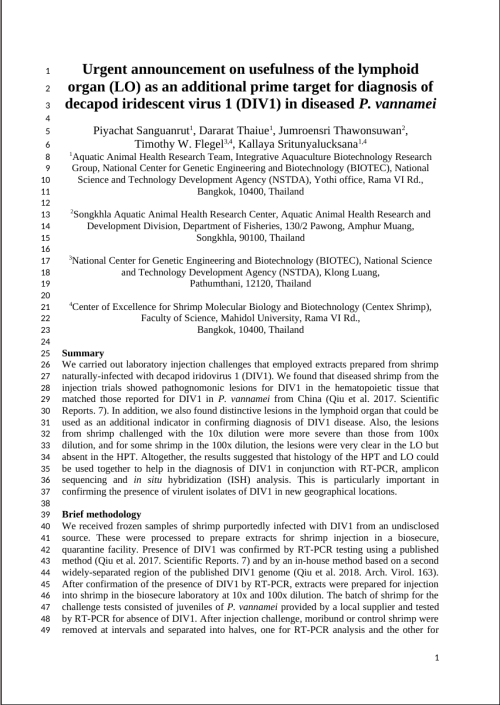Urgent announcement on usefulness of the lymphoid organ (LO) as an additional prime target for diagnosis of decapod iridescent virus 1 (DIV1) in diseased P. vannamei
20 February 2020 | Piyachat Sanguanrut, Dararat Thaiue, Jumroensri Thawonsuwan, Timothy W. Flegel, Kallaya Sritunyalucksana | 2427 Downloads | .pdf | 1.66 MB | Health and Biosecurity, Shrimp
NACA would like to thank the authors for sharing this information with the network - Ed.
We carried out laboratory injection challenges that employed extracts prepared from shrimp naturally-infected with decapod iridovirus 1 (DIV1). We found that diseased shrimp from the injection trials showed pathognomonic lesions for DIV1 in the hematopoietic tissue that matched those reported for DIV1 in P. vannamei from China (Qiu et al. 2017. Scientific Reports. 7). In addition, we also found distinctive lesions in the lymphoid organ that could be used as an additional indicator in confirming diagnosis of DIV1 disease. Also, the lesions from shrimp challenged with the 10x dilution were more severe than those from 100x dilution, and for some shrimp in the 100x dilution, the lesions were very clear in the LO but absent in the HPT.
Altogether, the results suggested that histology of the HPT and LO could be used together to help in the diagnosis of DIV1 in conjunction with RT-PCR, amplicon sequencing and in situ hybridization (ISH) analysis. This is particularly important in confirming the presence of virulent isolates of DIV1 in new geographical locations.
Creative Commons Attribution.

